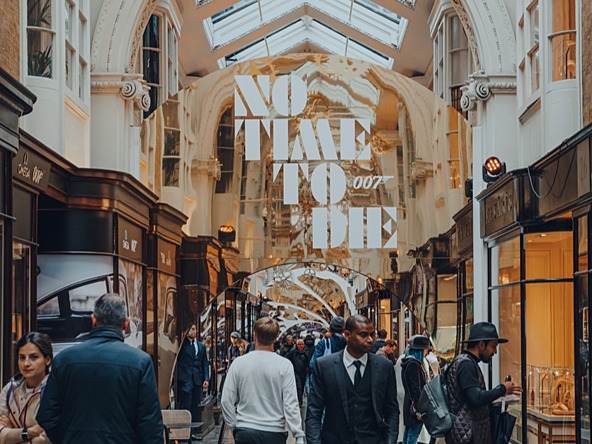All in the assemblage: How brands can retain relevance

Since the release of Dr. No in 1962, the James Bond movie franchise has generated over $8bn in box office revenue across 27 movies.[ 1 ] To put things in perspective, it is estimated that half of the world’s population has seen at least one James Bond film.[ 2 ] Over the years, this cinematic embodiment of British sophistication secured numerous product placements and brand partnerships with the likes of Omega, Aston Martin and Tom Ford, along with more mainstream brands such as Michael Kors, Heineken and La Perla.
Over the last 60 years, the James Bond brand could easily have fallen by the wayside. Instead, it evolved by constantly assembling original brand assets with newer attributes that aligned with Bond’s contemporary societal and cultural environment.
As such, James Bond’s constant distinctive brand assets include the opening scene, his Aston Martin, tuxedo and vodka martini. Other aspects and characters of the franchise have evolved as well: Miss Moneypenny (M’s secretary) is now embodied by a black actress (Naomi Harris). James Bond’s enemies evolved from the Eastern bloc to North Korea to an overarching virtual evil. Q (who creates and delivers James Bond’s gadgets) is now openly gay, which does not phase James Bond or Moneypenny.
The James Bond brand is an assemblage. It combines old and new attributes to engage fans and brand partners over time by staying relevant and attuned to its sociocultural and economic environment.
What is assemblage?
Assemblage is a French word that refers to the art and science of blending different eaux-de-vies (brandies) before bottling cognac. It is the craft of the maître de chai (also known as the master blender or cellar master) to select brandies from dozens of samples and craft a unique cognac. The art of assemblage combines what nature brings — the harvests — along with empirical knowledge of the craft.
Assemblage is also a metaphor for building successful brands:
- Like a brand manager, the master blender is responsible for the consistency of the product over time. They do not just select but also oversee the vineyard, the harvest and the brandy’s aging process
- The master blender combines rigour, precision and intuition to create a unique product. They are visionaries who anticipate the product’s development
- The master blender must also listen to consumers to understand how their tastes evolve and what products they are most likely to buy
- The quality of the raw product is just as important as a network of trusted suppliers and the vision of the master blender.
In brand assemblages, elements are brought together, shaped and ordered by actors that have the authority and legitimacy to do so. Assemblages can include people, physical features and technologies that allow the consumer to access the brand and its products.
- Brands are dynamic assemblages of social and cultural attributes that form clusters of association and meaning
- Brand components can be added or removed. As such, the art and science of assemblage assess the fit between different brand elements to ensure brand longevity
- Stories that connect brands to a wider sociocultural context are central to establishing consumer engagement
- Brands are dynamic and fluid; new components to assemblages can help stabilise or destabilise the brand, and understanding and balancing assemblages allow companies to mediate continuity and change.
Assemblages go through two articulations. First, the attributes, drawn from a wide set of materials, are quantified. In the second articulation, these materials are coded, that is, the assemblage is solidified and endorses a specific meaning.[ 3 ]
Just like in wine assemblages, components of brand assemblages have “capacities” to evolve and transform when they interact with other elements. When the audience is involved in the assemblage, people find comfort and satisfaction in contributing to the brand, imagining other possible variations, and predicting attributes that will be part of the assemblage’s next iteration.
What makes assemblage so difficult?
Today, brands no longer have a single meaning. Brand identity is defined in specific contexts and actors (consumers, citizens, the public, key opinion formers, businesses) give meaning to brands in context. Brands are continuously open to contestations from consumers that shape their narratives, meanings, and relationships with these brands. In particular, we shape, contest, and augment the identity of brands on social media through our own manifestation of the brand. As such, we create a narrative by navigating the brand’s primary narrative and modifying it through our creative posts and interaction with others.
Rather than controlling the brand narrative, brand managers now monitor, moderate and channel brand contestation from consumers. To succeed in the long run, brand managers increasingly endorse the role of brand ambassadors who must listen to and represent the brand’s audience. The brands they create can only just sell products, but must also make a positive impact on people and the world they live in.
Emmanuel Probst is global lead: brand growth and thought leadership at Ipsos North America
[ 1 ] Spotify. 2022. Spotify—About Spotify. [online] Available at: <https://newsroom.spotify.com/company-info/> [Accessed 30 April 2022 ].
[ 2 ] A. Millard, Equipping James Bond (Johns Hopkins University Press, 2018 ).
[ 3 ] Manuel DeLanda, Assemblage Theory (Edinburgh: Edinburgh University Press, 2016 ).

We hope you enjoyed this article.
Research Live is published by MRS.
The Market Research Society (MRS) exists to promote and protect the research sector, showcasing how research delivers impact for businesses and government.
Members of MRS enjoy many benefits including tailoured policy guidance, discounts on training and conferences, and access to member-only content.
For example, there's an archive of winning case studies from over a decade of MRS Awards.
Find out more about the benefits of joining MRS here.













0 Comments